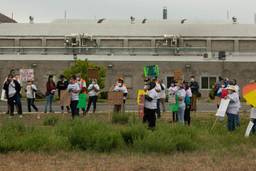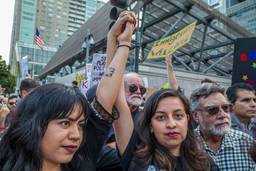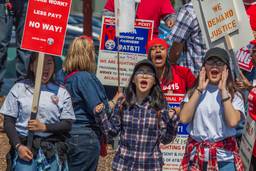Utah’s New Immigration Bills: A Blast From the Past
The state laws have been called “the nation’s most liberal,” but they’re not much different from Cold War-era deportation policies.
David Bacon

Last week the Utah legislature passed three new laws that have been hailed in the media as a new, more reasonable, approach to immigration policy. Reasonable, that is, compared to Arizona’s S.B. 1070, which would allow police to stop anyone, demand immigration papers and hold her or him for deportation. Utah’s law was signed by Republican Governor Gary Herbert on Tuesday, March 15. Arizona’s S.B. 1070 is currently being challenged in court.
Utah’s bills were called “the anti-Arizona” by Frank Sharry, head of America’s Voice, a Washington D.C. immigration lobbying firm. According to Lee Hockstader, on the Washington Post’s editorial staff, the laws are “the nation’s most liberal – and most reality-based – policy on illegal immigration.”
The Utah laws, however, are not new. And they’re certainly not liberal, at least towards immigrants and workers. Labor supply programs for employers, with deportations and diminished rights for immigrants, have marked U.S. immigration policy for more than 100 years.
One bill would establish a state system to allow employers to bring people from the Mexican state of Nuevo Leon as “guest workers.” Under this program, workers would have to remain employed to stay in the country. They would not have the same set of labor and social rights as people living in the communities around them. Another bill would give undocumented workers now living in Utah a similar guest worker status, lasting two years. The National Immigration Law Center (NILC) says the third bill, the Arizona look-alike, “requires police to interrogate individuals and verify their immigration status in a wide array of situations, promoting harmful and costly incentives for law enforcement to racially profile.”
Utah, like most states in the west and Midwest, has been down this road before.
From 1930 to 1935, 345,839 Mexicans were deported from the United States. Last year alone, the federal government deported almost 400,000. Given the growth in population, this is about the equivalent of that Depression-era wave.
In those years, “the climate of scathing anti-Mexican sentiment created intense polarization, producing a sweeping suspicion of foreigners … which linked housing congestion, strained relief services and social ills to the large presence of Mexicans,” recounts Zaragosa Vargas, professor at the University of North Carolina. Most immigrants in Utah were farm workers, many laboring in sugar beet fields for the Mormon-backed Utah and Idaho Sugar Company. Their wages were so low that families went hungry even when they were working. When beet workers in nearby Colorado tried to organize a union and went on strike, Vargas says their communities were targeted with deportations.
Then W.W. II created a labor shortage. To supply workers to growers at low wages, the government started the bracero contract labor program, bringing immigrants first into the beet fields of Stockton, California, and then into the rest of the country in 1942.
Braceros were treated as disposable, dirty and cheap. Herminio Quezada Durán, who came to Utah from Chihuahua, says ranchers often had agreements between each other to exchange or trade braceros as necessary for work. Jose Ezequiel Acevedo Perez, who came from Jerez, Zacatecas, remembers the humiliation of physical exams that treated Mexicans as louse-ridden.
“We were stripped naked in front of everyone,” he remembers, and sprayed with DDT, now an outlawed pesticide. Men in some camps were victims of criminals and pimps. Juan Contreras, from Tuxtla Gutierrez, Chiapas, tactfully recalls that “in Utah, women often went to the camps, and they were rumored to be especially fond of Mexican men.”
Utah and Idaho Sugar first used labor from the Japanese internment camps in Minidoka, Idaho; Topaz, Utah; and Heart Mountain, Wyoming. When that wasn’t enough, they brought in braceros.
At the height of the cold war, in the late 1950s, the combination of enforcement and contract labor reached a peak. In 1954, 1,075,168 Mexicans were deported from the U.S. And from 1956 to 1959, between 432,491 and 445,197 braceros were brought in each year.
The Civil Rights Movement ended the bracero program, and created an alternative to the deportation regime. Chicano activists of the 1960s – Ernesto Galarza, Cesar Chavez, Bert Corona, Dolores Huerta and others – convinced Congress in 1964 to repeal Public Law 78, the law authorizing the bracero program. Farm workers went on strike the year after in Delano, California, and the United Farm Workers was born. They also helped to convince Congress in 1965 to pass immigration legislation that established new pathways for legal immigration - the family preference system. People could reunite their families in the U.S. Migrants received permanent residency visas, allowing them to live normal lives, and enjoy basic human and labor rights. Essentially, a family- and community-oriented system replaced the old labor supply/deportation program.
The new (old) deportation regime
Today Congress, and now the states, are sliding back into those cold war ideas. That slide didn’t start in Salt Lake City. For five years Congress has debated, and almost passed, bills that would have done the same thing – vastly increased immigration enforcement and set up huge new guest worker programs. Some undocumented people might have been able to gain legal status, but most bills would have forced them into a temporary status, a la Utah.
This combination was defended by Michael Chertoff, secretary of Homeland Security under President Bush. “There’s an obvious solution to the problem of illegal work,” he said, “which is you open the front door and you shut the back door.” “Opening the front door” refers to guest worker programs, and “closing the back door” means heavy immigration enforcement.
The Council on Foreign Relations proposed the same goals when President Obama took office. “We should reform the legal immigration system,” its 2009 report advocated, “so that it operates more efficiently, responds more accurately to labor market needs, and enhances U.S. competitiveness.” At the same time, “we should restore the integrity of immigration laws through an enforcement regime that strongly discourages employers and employees from operating outside that legal system.” This again couples labor at competitive, or low, wages, with an enforcement regime of raids and firings.
Sound like Utah?
Today the number of deportations is rising. Thousands of undocumented workers are being fired from their jobs as part of the same enforcement policy. And in California, for instance, where only one grower historically used the current H2-A federal guest worker program for farm workers, dozens are now using it today. What Congress couldn’t or wouldn’t pass is becoming the reality on the ground.
Utah’s guest worker bill was written by a dairy farmer. “The root of this discussion is productivity,” according to the bill’s sponsor, State Rep. Bill Wright. To this conservative Republican, no one has a right to a job, immigrant or native-born. “People think because you’re born here … ‘I have a right to that job, I’m going to charge what I want for my labor even if I’m not productive.’ Wrong.”
But if those immigrants try to organize and get more expensive, or are just lazy and don’t work, he warns, they “need to go.”
The Utah bills were the product of negotiations, called the Utah Compact, between the Salt Lake Chamber, a statewide business group; and the Salt Lake City Police Department and mayor’s office. The Mormon Church of Latter Day Saints and the Catholic Church signed off on it, as did some local immigrant advocates.
An unconstitutional overreach
One thing, however, that many other anti-immigrant nativists and immigrant rights advocates agree on, for different reasons, is that Utah’s bills are unconstitutional. Dan Stein, president of the anti-immigrant Federation for American Immigration Reform, says, “States do not have the constitutional authority to write their own immigration policies.” FAIR wants the Federal government to stop almost all immigration and deport the 12 million undocumented people living in the United States. It sees the Utah bills as too weak, although it supports Arizona’s SB 1070.
NILC’s Marielena Hincapie calls the Utah laws “fundamentally unconstitutional. Taken together, the laws signify an even more sweeping state takeover of federal immigration regulation.” NILC supports legislation legalizing undocumented people, and believes it must pass at a Federal level.
One prominent Washington D.C. immigration think tank, the Immigration Policy Center, supported the labor supply/enforcement/legalization bills of the last few years. It also criticizes the constitutionality of state immigration bills, but declares, “Enforcement strategies must be coupled with reform of our legal system of immigration in order to meet legitimate labor force needs.”
That declaration moves beyond states’ rights to set immigration policy, and restates a vision it believes should guide immigration reform. But is it an alternative to the Utah bills?
Some immigration reformers argue for a different system, as Chicano and Asian activists did in the 1960s, that would give immigrants a way to come to the U.S with social equality and rights. Among them are the Binational Front of Indigenous Organizations in California and Oaxaca, Derechos Humanos in Tucson, Ariz., the Mississippi Immigrants Rights Alliance, and the AFL-CIO’s constituency group for Latino workers, the Labor Council for Latin American Advancement. They’ve agreed on the basic principles of what they call the Dignity Campaign.
People coming to the U.S. would have access to permanent residence, rather than being forced into guest worker programs. The current wave of deportations and mass firings would be halted, while protections for labor and human rights would be strengthened. To diminish job competition in an era of high unemployment, the Federal government would establish programs guaranteeing a job for anyone wanting to work. And U.S. trade policy in countries like Mexico would stop promoting unemployment and poverty, which boost corporate profits but create the pressure for migration.
Utah’s laws are no closer to changing U.S. immigration policy than are these proposals. In reality, political movement towards immigration reform is deadlocked in Washington D.C. No legislation in Salt Lake City will change that.
But that’s not really its purpose. Utah legislators want to popularize an immigration policy that has strong corporate support and deep historical roots, in one of the most conservative, Republican statues in the country. And they are well on the road toward accomplishing that.







